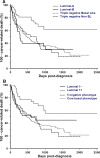Canine invasive mammary carcinomas as models of human breast cancer. Part 2: immunophenotypes and prognostic significance
- PMID: 29063312
- PMCID: PMC5790838
- DOI: 10.1007/s10549-017-4542-8
Canine invasive mammary carcinomas as models of human breast cancer. Part 2: immunophenotypes and prognostic significance
Abstract
Purpose: Relevant animal models of human breast cancer are currently needed, especially for the aggressive triple-negative breast cancer subtype. Recent studies and our results (Part 1) indicate that spontaneous canine invasive mammary carcinomas (CMCs) resemble human breast cancer by clinics and pathology as well as behavior and prognostic indicators. We hypothesized that the current molecular classifications of human breast cancer, used for therapeutic decision, could be relevant to dogs.
Methods: Three hundred and fifty female dogs with spontaneous CMC and a 2-year follow-up were retrospectively included. By immunohistochemistry, CMCs were classified according to Nielsen (Clin Cancer Res 10:5367-5374, 2004) and Blows (PlosOne doi: 10.1371/journal.pmed.1000279, 2010) into the subtypes of human breast cancer.
Results: Four immunophenotypes were defined either according to Nielsen classification (luminal A 14.3%, luminal B 9.4%, triple-negative basal-like 58.6%, and triple-negative nonbasal-like 17.7% CMCs); or to Blows classification (luminal 1-: 11.4%, luminal 1+: 12.3%, Core basal phenotype: 58.6%, and five-negative phenotype: 17.7%). No HER2-overexpressing CMC as defined by a 3 + immunohistochemical score was observed in our cohort. By univariate and multivariate analyses, both immunophenotypical classifications applied to CMCs showed strong prognostic significance: luminal A or luminal 1+ CMCs showed a significantly longer disease-free interval (HR = 0.46), Overall (HR = 0.47), and Specific Survival (HR = 0.56) compared to triple-negative carcinomas, after adjustment for stage.
Conclusions: In our cohort, triple-negative CMCs largely predominated (76%), were much more prevalent than in human beings, and showed an aggressive natural behavior after mastectomy. Dogs are thus potent valuable spontaneous models to test new therapeutic strategies for this particular subtype of breast cancer.
Keywords: Animal model; Breast cancer; Dog; Immunophenotype; Luminal; Triple-negative.
Conflict of interest statement
Conflicts of interest
The authors declare that they have no conflict of interest.
Ethical approval
All applicable international, national, and/or institutional guidelines for the care and use of animals were followed. The owners’ written consent and approval from the Oniris College of Veterinary Medicine local Animal Welfare Committee were obtained prior to inclusion of each canine mammary carcinoma in this retrospective observational study.
Figures


Similar articles
-
Androgen receptor and FOXA1 coexpression define a "luminal-AR" subtype of feline mammary carcinomas, spontaneous models of breast cancer.BMC Cancer. 2019 Dec 30;19(1):1267. doi: 10.1186/s12885-019-6483-6. BMC Cancer. 2019. PMID: 31888566 Free PMC article.
-
The dog as a naturally-occurring model for insulin-like growth factor type 1 receptor-overexpressing breast cancer: an observational cohort study.BMC Cancer. 2015 Oct 8;15:664. doi: 10.1186/s12885-015-1670-6. BMC Cancer. 2015. PMID: 26449867 Free PMC article.
-
Identification of an immune-suppressed subtype of feline triple-negative basal-like invasive mammary carcinomas, spontaneous models of breast cancer.Tumour Biol. 2020 Jan;42(1):1010428319901052. doi: 10.1177/1010428319901052. Tumour Biol. 2020. PMID: 31959092
-
Salivary gland-like tumors of the breast express basal-type immunohistochemical markers.Appl Immunohistochem Mol Morphol. 2013 Jul;21(4):283-6. doi: 10.1097/PAI.0b013e31826a277e. Appl Immunohistochem Mol Morphol. 2013. PMID: 22935826 Review.
-
Exosomes as Biomarkers of Human and Feline Mammary Tumours; A Comparative Medicine Approach to Unravelling the Aggressiveness of TNBC.Biochim Biophys Acta Rev Cancer. 2020 Dec;1874(2):188431. doi: 10.1016/j.bbcan.2020.188431. Epub 2020 Sep 17. Biochim Biophys Acta Rev Cancer. 2020. PMID: 32950643 Review.
Cited by
-
Integrated Study of Canine Mammary Tumors Histopathology, Immunohistochemistry, and Cytogenetic Findings.Vet Sci. 2024 Sep 4;11(9):409. doi: 10.3390/vetsci11090409. Vet Sci. 2024. PMID: 39330788 Free PMC article.
-
One-year conditional survival of dogs and cats with invasive mammary carcinomas: A concept inspired from human breast cancer.Vet Comp Oncol. 2021 Mar;19(1):140-151. doi: 10.1111/vco.12655. Epub 2020 Sep 28. Vet Comp Oncol. 2021. PMID: 32954630 Free PMC article.
-
Deregulation of VEGFR-2 and PDGFR Expression and Microvascular Density in a Triple-Negative Model of Canine Malignant Mammary Tumors with Lymph Node or Lung Metastasis.Vet Sci. 2019 Jan 9;6(1):3. doi: 10.3390/vetsci6010003. Vet Sci. 2019. PMID: 30634402 Free PMC article.
-
The development of molecular typing in canine mammary carcinomas.Mol Biol Rep. 2022 Sep;49(9):8943-8951. doi: 10.1007/s11033-022-07383-4. Epub 2022 Jul 16. Mol Biol Rep. 2022. PMID: 35841467 Review.
-
Prognostic significance of immunohistochemical markers and histological classification in malignant canine mammary tumours.Vet Comp Oncol. 2020 Dec;18(4):753-762. doi: 10.1111/vco.12603. Epub 2020 May 22. Vet Comp Oncol. 2020. PMID: 32336005 Free PMC article.
References
-
- NHS Cancer Screening Programmes and The Royal College of Pathologists (2005) Pathology Reporting of Breast Disease: A Joint Document Incorporating the Third Edition of the NHS Breast Screening Programme’s Guidelines for Pathology Reporting in Breast Cancer Screening and the Second Edition of The Royal College of Pathologists’ Minimum Dataset for Breast Cancer Histopathology. Sheffield. https://www.gov.uk/government/uploads/system/uploads/attachment_data/fil.... Accessed 5 Nov 2016
-
- Goldhirsch A, Ingle JN, Gelber RD, Coates AS, Thürlimann B, Senn HJ, et al. Strategies for subtypes–dealing with the diversity of breast cancer: highlights of the St. Gallen International Expert Consensus on the Primary Therapy of Early Breast Cancer 2011. Ann Oncol. 2009;20:1319–1329. doi: 10.1093/annonc/mdp322. - DOI - PMC - PubMed
Publication types
MeSH terms
Substances
Grants and funding
LinkOut - more resources
Full Text Sources
Other Literature Sources
Research Materials
Miscellaneous

